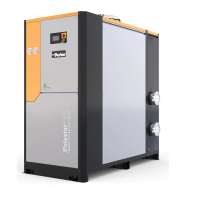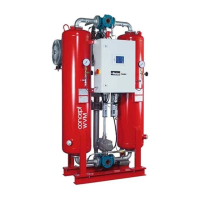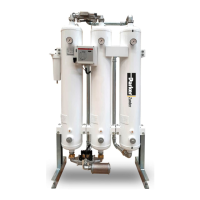EN | User Manual Technical product description
K-MT 10-95/D3 15
Function description
The dryer dries the compressed air supplied by the compressor and makes it available for
industrial use.
Upstream lters clean the compressed air and remove dust, dirt, oil, and water droplets, be-
fore the compressed air reaches the dryer. Thus, an upstream lter is also used for extending
the service life of the drying agent.
Downstream lters clean the compressed air from drying agent abrasions, before it is fed into
the compressed air system.
The two chambers of the hollow section vessel contain an extremely porous drying agent by
means of which humidity is removed from the compressed air and stored just as in a sponge.
The stored humidity is then removed again from the drying agent and re-introduced into the
ambient environment.
To this end, the two chambers alternate between different operating modes. Whilst in one
vessel, compressed air is de-humidi ed (adsorption), in the other vessel the humid drying
agent is prepared for another charge (regeneration). These two states, which run in parallel
during compressed air preparation, are described below.
Adsorption
Via a compressor, humid compressed air is
supplied to the upstream lter. From here, the
compressed air ows upwards through the
absorption chamber, which is pressurised. In
so doing, the drying agent dehumidi es the air.
The dry compressed air is supplied to the pipe
network via the downstream lter.
Here, adsorption is shown in the left
vessel.
Regeneration (running in parallel to the adsorption)
At the same time the other chamber is prepared for a renewed take-up of humidity. This
process is called regeneration.
The regeneration is subdivided into three phases: expansion, dehumidi cation, and pres-
sure build-up.
With the dewpoint-sensing control option, the regeneration phase is followed by a standby
phase.

